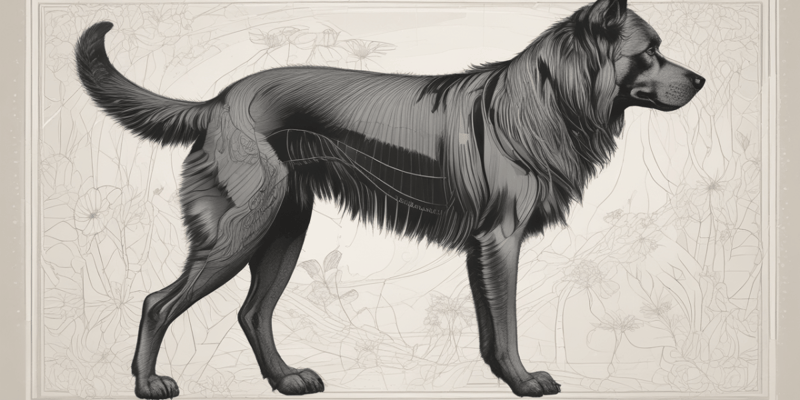55 Questions
What is the characteristic symptom of Gastrointestinal Hemorrhagic gastroenteritis?
Bloody diarrhoea
What is the common name for Hormonal Hyposomatotropism?
Growth hormone-responsive dermatosis
Which breed of dog is associated with bladder stones linked to a specific gene?
Dalmatians
What is the consequence of the dapple coat in Dachshunds?
Deafness and blindness
What is the common trait linked to aggression in Cocker spaniels?
Coat colour
In which breed of dog is Gastrointestinal Hemorrhagic gastroenteritis commonly found?
Miniature Schnauzers
What is the result of Hormonal Hyposomatotropism in dogs?
Failure of the body's growth hormones to develop fully
What is the consequence of selecting harmful genes in breeding?
Increased risk of genetic disorders
Which of the following coat characteristics is linked to deafness?
White coat
What is the relationship between the dapple coat and blindness in Dachshunds?
The dapple coat is linked to blindness
Gastrointestinal Hemorrhagic gastroenteritis is characterized by bloody urine and elevated hematocrit.
False
Hormonal Hyposomatotropism is common in miniature schnauzers.
False
The dapple coat in Dachshunds is linked to aggression.
False
White coat is linked to blindness in dogs.
True
Bladder stones in Dalmatians are linked to a specific coat color.
True
What does parturition refer to?
Giving birth
Why is it essential to prepare the environment before an animal gives birth?
To minimize the risk of infection
How do you know an animal is about to give birth?
By noticing changes in the mother's behavior
What is a crucial step in preparing for an animal's birth?
Preparing a safe and clean area
What should you do when an animal is about to give birth?
Monitor the mother's progress from a distance
Why is it essential to create a quiet environment before an animal gives birth?
To avoid startling the mother
What is the main reason to clean the birth area?
To prevent the spread of infection
What is the significance of the first 30 seconds after a puppy is born?
The mother removes the amniotic sac and tears the umbilical cord
Why is it important to provide a heated area for the puppies after birth?
To reduce the risk of hypothermia
What is the main goal when preparing an environment for an animal's birth?
To minimize stress and ensure a safe birth
Match the environmental adjustments with their purpose during parturition:
Quiet environment = Reduce stress and slow down birth Clean area = Prevent infections Heated area = Prevent hypothermia Secluded place = Avoid interruptions to bonding
Match the post-birth actions with their purpose:
Removing the amniotic sac and umbilical cord = Help mother bond with the puppy Providing a heated area = Keep the puppies warm Returning puppies to mother = Ensure they find the teat Avoiding interruptions = Prevent bonding issues
Match the parturition preparation steps with their importance:
Cleaning the area = Prevent infection Providing a quiet environment = Reduce stress Using disposable materials = Easy cleanup Creating a heated area = Prevent hypothermia
Match the post-birth events with their significance:
Mother removing amniotic sac and umbilical cord = First 30 seconds after birth Puppies finding the teat = Initial bonding Providing a heated area = Preventing hypothermia Avoiding interruptions = Ensuring bonding
Match the parturition considerations with their purpose:
Avoiding noisy environment = Reduce stress Using materials that can be thrown away = Easy cleanup Maintaining a clean area = Prevent infection Providing a secluded place = Reduce interruptions
What is the term for giving birth in horses?
Foaling
What is the term for giving birth in cattle?
Calving
What is the term for giving birth in rabbits?
Kindling
What is the term for giving birth in cats?
Queening
What is the term for giving birth in dogs?
Whelping
What is the term for giving birth in sheep?
Lambing
What is the term for giving birth in pigs?
Farrowing
Which of the following terms is used for giving birth in horses?
Foaling
What is the term for giving birth in rabbits?
Kindling
Which of the following terms is used for giving birth in dogs?
Whelping
The term for giving birth in pigs is Calving.
False
The term for giving birth in cats is Foaling.
False
The term for giving birth in sheep is Lambing.
True
The term for giving birth in rabbits is Whelping.
False
The term for giving birth in dogs is Farrowing.
False
What is the term for giving birth in cattle?
Calving
What is the term for giving birth in dogs?
Whelping
What is the term for giving birth in rabbits?
Kindling
What is the term for giving birth in horses?
Foaling
What is the term for giving birth in cats?
Queening
What is a common physical indicator of approaching parturition in dogs?
Relaxed pelvic ligaments
Which hormone is released during parturition in dogs?
Oxytocin
What is a behavioral sign of impending parturition in dogs?
Pawing the ground and separating from the group
What is a physical change that occurs in the mammary glands during parturition?
Increased milk secretion
What is a common change in a dog's body temperature during parturition?
Decreased body temperature
Study Notes
Gastrointestinal Hemorrhagic Gastroenteritis
- Acute disorder characterized by bloody diarrhoea, elevated hematocrit, and shock
- Commonly affects Miniature Schnauzers
Hormonal Hyposomatotropism
- Failure of body growth hormones (somatomedins) to develop fully
- Also known as growth hormone-responsive dermatosis
- Commonly affects Pomeranians
Selection of Harmful Genes
- White coat linked to deafness
- Bladder stones in Dalmatians linked to gene responsible for spots
- Coat colour linked to aggression in Cocker Spaniels
- Dapple coat linked to blindness and deafness in Dachshunds
Gastrointestinal Hemorrhagic Gastroenteritis
- Acute disorder characterized by bloody diarrhoea, elevated hematocrit, and shock
- Commonly affects Miniature Schnauzers
Hormonal Hyposomatotropism
- Failure of body growth hormones (somatomedins) to develop fully
- Also known as growth hormone-responsive dermatosis
- Commonly affects Pomeranians
Selection of Harmful Genes
- White coat linked to deafness
- Bladder stones in Dalmatians linked to gene responsible for spots
- Coat colour linked to aggression in Cocker Spaniels
- Dapple coat linked to blindness and deafness in Dachshunds
Gastrointestinal Hemorrhagic Gastroenteritis
- Acute disorder characterized by bloody diarrhoea, elevated hematocrit, and shock
- Commonly affects Miniature Schnauzers
Hormonal Hyposomatotropism
- Failure of body growth hormones (somatomedins) to develop fully
- Also known as growth hormone-responsive dermatosis
- Commonly affects Pomeranians
Selection of Harmful Genes
- White coat linked to deafness
- Bladder stones in Dalmatians linked to gene responsible for spots
- Coat colour linked to aggression in Cocker Spaniels
- Dapple coat linked to blindness and deafness in Dachshunds
Preparing for Parturition
- Create a safe and clean environment for the animal to give birth, free from distractions and stress
- Ensure a comfortable and quiet space with adequate bedding and ventilation
- Prepare necessary equipment and supplies, such as towels, gloves, and cleaning materials
Recognizing Signs of Impending Birth
- Monitor the animal's behavior and physical changes, such as restlessness, nesting, and/or vocalization
- Look for signs of udder engorgement, pelvic changes, and/or vaginal discharge
- Take note of changes in appetite, temperature, and/or abdominal size
Assisting the Birth
- Provide a calm and supportive environment, allowing the animal to give birth naturally
- Be prepared to assist if necessary, but avoid intervening unnecessarily
- Monitor the birth process and ensure the animal and newborn are healthy and safe
Preparing the Environment for Parturition
- Create a quiet, secluded area for birth to reduce stress and slow down the process
- Ensure the area is clean by using disposable materials that can be easily thrown away
- Maintain a comfortable temperature, ideally using a heated area or electric blanket, to prevent hypothermia
Recognizing the Onset of Parturition
- Monitor the animal for signs of impending birth, although exact timing may be difficult to predict
Assisting the Birth Process
- Allow the mother to remove the amniotic sac and tear the umbilical cord within the first 30 seconds after birth
- Avoid interruptions to the bonding process, but step in if the health of the mother or puppies is at risk
- Return puppies to the mother so they can find the teat and initiate nursing
Preparing the Environment for Parturition
- Create a quiet, secluded area for birth to reduce stress and slow down the process
- Ensure the area is clean by using disposable materials that can be easily thrown away
- Maintain a comfortable temperature, ideally using a heated area or electric blanket, to prevent hypothermia
Recognizing the Onset of Parturition
- Monitor the animal for signs of impending birth, although exact timing may be difficult to predict
Assisting the Birth Process
- Allow the mother to remove the amniotic sac and tear the umbilical cord within the first 30 seconds after birth
- Avoid interruptions to the bonding process, but step in if the health of the mother or puppies is at risk
- Return puppies to the mother so they can find the teat and initiate nursing
Parturition Names in Species
- Cattle: Calving
- Sheep: Lambing
- Pigs: Farrowing
- Horses: Foaling
- Dogs: Whelping
- Cats: Queening
- Rabbits: Kindling
Parturition Names in Species
- Cattle: Calving
- Sheep: Lambing
- Pigs: Farrowing
- Horses: Foaling
- Dogs: Whelping
- Cats: Queening
- Rabbits: Kindling
Parturition Names in Species
- Cattle: Calving
- Sheep: Lambing
- Pigs: Farrowing
- Horses: Foaling
- Dogs: Whelping
- Cats: Queening
- Rabbits: Kindling
Parturition Names in Species
- Cattle: Calving
- Sheep: Lambing
- Pigs: Farrowing
- Horses: Foaling
- Dogs: Whelping
- Cats: Queening
- Rabbits: Kindling
General Signs of Parturition
- A distended abdomen is a visible indication of pregnancy
- Decreased appetite is a common symptom experienced by expectant mothers
- Oxytocin is released to stimulate contractions during childbirth
- Mammary glands develop and secrete milk in preparation for lactation
- Swelling of the vulva and relaxation of pelvic ligaments are physical changes that occur
- A mucous discharge is a normal and natural occurrence prior to parturition
- Restlessness and separation from the rest of the group are behavioral changes that may indicate impending parturition
- Pawing the ground, as if to build a nest, is a maternal instinct exhibited by expectant mothers
- Labor contractions are a critical sign that parturition is imminent
- A decrease in the mother's body temperature is a physiological change that occurs prior to parturition
This quiz covers various genetic disorders that affect dogs, including Gastrointestinal Hemorrhagic Gastroenteritis, Hormonal Hyposomatotropism, and Selection of Harmful Genes. Learn about the characteristics, symptoms, and breeds commonly affected by these disorders.
Make Your Own Quizzes and Flashcards
Convert your notes into interactive study material.
Get started for free





